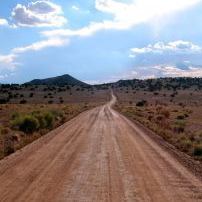Travel News
Life is a Highway When You’re Rolling in an RV
 This summer holiday, travelers are overlooking soaring gas prices and hitting the road. AAA has estimated that 40.3 million Americans be traveling over the week, up from 39.4 million travelers last year.
This summer holiday, travelers are overlooking soaring gas prices and hitting the road. AAA has estimated that 40.3 million Americans be traveling over the week, up from 39.4 million travelers last year.
With numbers like these, chances are you’ll see hordes of vans, trailers and motorhomes heading out on the open road. Family-friendly and often economical, RV travel is a time-honored American tradition that is now getting more attention than ever.
If you haven’t been bitten by the RV bug yet, you may be surprised to learn just how hot this activity has grown over the past few years. According to the Recreating Vehicle Industry Association (RVIA), one in 12 U.S. vehicle-owning households own at least one RV–that’s about 8 million households. This number represents a 15 percent increase since 2001, and a 58 percent increase since 1980. By 2010, RVIA estimates that 8.5 million households will own at least one RV.
So what’s the big attraction?
“I always say it’s like a John Steinbeck-meets-James Bond symbol of freedom and technology,” says Brad Herzog, an RV enthusiast who is speaking from a campground in Yellowstone National Park. “You’ve got the adventure of the open road and all the comforts of home. Looking through the windshield, it’s like you’re watching a movie of America, and you can stop at any point and enter the picture.”
Herzog, a writer, and his wife Amy took their first RV trip 12 years ago. “We wanted to sample life’s options before settling down.” The couple set out for 10 months, driving 35,000 miles and 48 states. “We fell in love with the RV experience. It’s traveling in style.” With two young sons, ages 5 and 6, the couple continues to travel at least a couple of months every summer, focusing on particular sections of the U.S. each year.
Traveling by RV certainly can be an experience in style, but the options range from basic to super luxurious. According to RVIA, there are at least six types of towable RVs and three classes of motorhomes. Prices can start from $4,000 to $13,000 for a towable, folding camping trailer. This type can sleep up to eight people, and are designed to be light, portable and affordable, which makes it popular with first-time buyers. Conveniences like showers, toilets and stoves may not be included in the lower-priced models.
A pricier sports utility RV costs about $21,000 to $58,000 and includes storage space for sports equipment like ATVs, snowmobiles and motorcycles. The most luxurious of the bunch, a Class A motorhome, has all the amenities of home—and can run you anywhere from $58,000 to $500,000.
RV parks can also range from extremely rustic to high end, including both public spaces and member-only sites. The most basic sites will usually include water hookups, public restrooms and a supply store. Free wireless internet is becoming a common amenity in RV parks and, along with cell phones, makes it easier than ever to stay connected with the outside world…even when you’re out on the open road.
RV travel has become a big hit among families and group travel–if you go for a more budget-oriented vehicle, you can save money on hotel rooms and dining out, while keeping the kids occupied while on the road. But while the largest vehicles can be as long as 45 feet (think yellow school buses), chances are you’ll be spending your family vacation in a much more confined space. Will all that togethernesss drive you crazy? “Families will get on your nerves no matter what you’re doing. With RV travel, there’s literally a new adventure around every corner. That keeps things fresh,” says Herzog.
He recommends staying off the major highways and taking the smaller roads that can lead you to small towns, local diners and unusual attractions. “Some of the best experiences aren’t the major attractions– there’s a more interesting subculture…why not go see the world’s biggest ball of twine?”
As for the kids, “[RVing] is education disguised as entertainment. They just don’t realize it yet.”
The folks at RVIA offer this advice our readers who may be hitting the road this summer:
–Get good directions.
–Take a safety course. While driving an RV is not difficult, less experienced drivers may want to get some instruction on how to drive a larger vehicle. Rental companies, RV dealers, and RV clubs can help people find a good class.
–Ensure a trouble-free trip by planning ahead and checking your RV before each trip. Take a few minutes before setting and:
-Make sure electrical and plumbing systems are ready for use
-Check fluids, brakes and tires
-Adjust mirrors
-Check hitch and coupling systems.
–Here are a few things you may want to have on board:
-Batteries
-Blankets
-Camera and film, or a digital camera
-First aid kit
-Flashlights
-Games
-Insect repellent
-Rain gear
-Sunscreen
–Take it easy. When you’re RVing, there’s no schedule to keep, no flights to catch, no hotel reservations to worry about. Take your time, explore interesting sites along your route, and enjoy the ride.
–Some RVers like to arrive at the campground before sundown so they can set up their campsite in the daylight. Don’t worry if you can’t make it there until after dark – connecting water, electricity and cable TV (if available) is a simple procedure that can be done with illumination from a flashlight.
–As you would be in any area where other people are around, don’t make excessive noise or let your pets become a nuisance. Do clean up after yourself, and say hello – RVers are generally a friendly group.
–Need help? Just knock on the door of your nearest campground neighbor. RV enthusiasts are usually friendly and helpful.
For more information, visit:
- Recreation Vehicle Industry Association
- Tips on RV rentals, purchasing and planning your travel
- RV campgrounds, dealers and repair services
- RV parks listed by state
- RV parks and campgrounds by state
- RV parks and campgrounds with free WiFi hotspots
Top photo courtesy of RVIA.org
For more, visit our RV Travel section.












